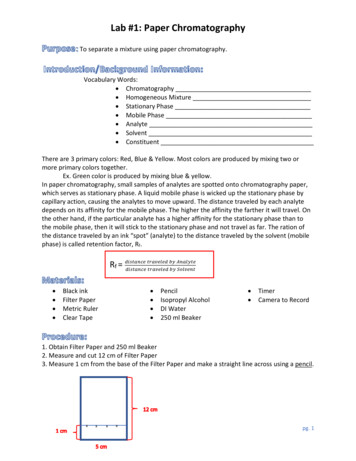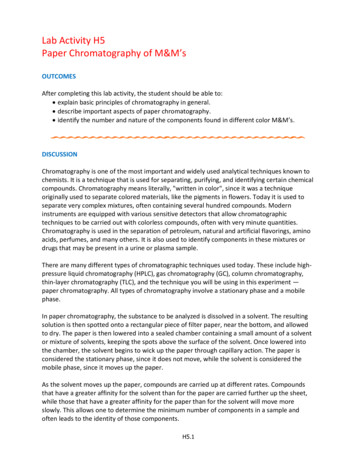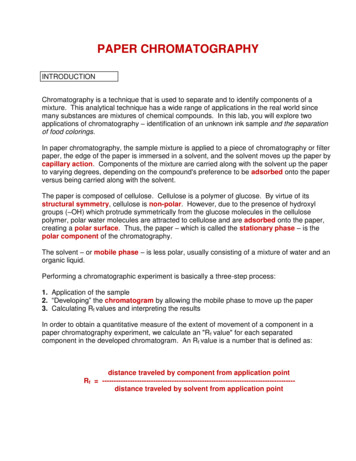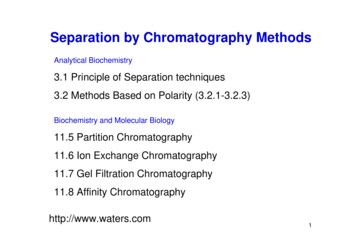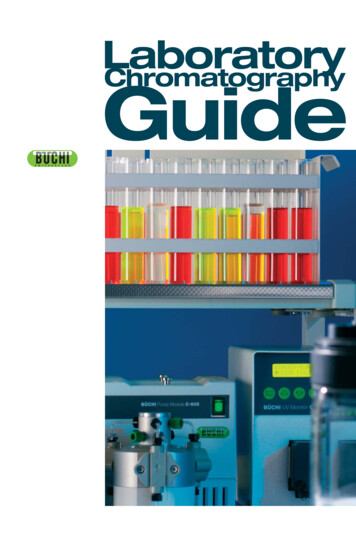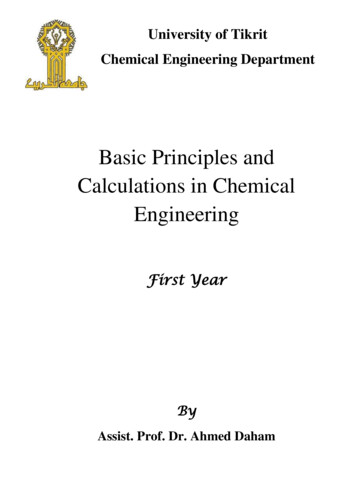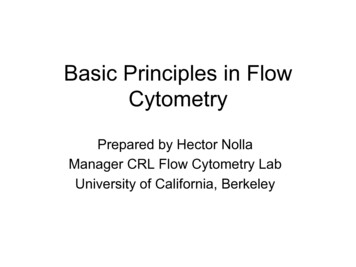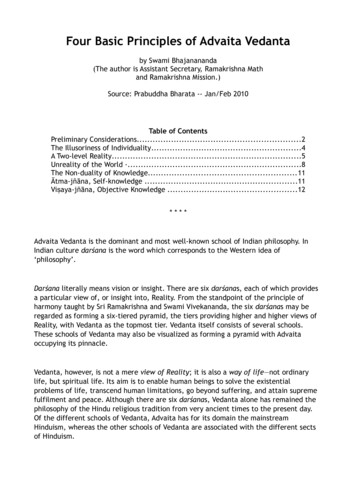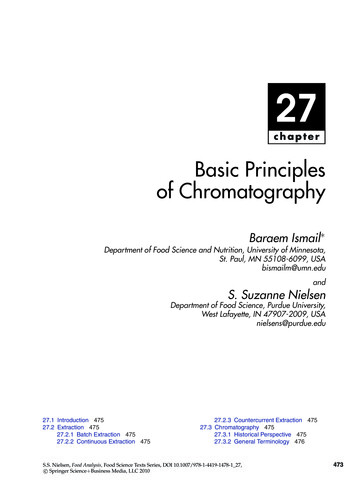
Transcription
27chapterBasic Principlesof ChromatographyBaraem Ismail Department of Food Science and Nutrition, University of Minnesota,St. Paul, MN 55108-6099, USAbismailm@umn.eduandS. Suzanne NielsenDepartment of Food Science, Purdue University,West Lafayette, IN 47907-2009, USAnielsens@purdue.edu27.1 Introduction 47527.2 Extraction 47527.2.1 Batch Extraction 47527.2.2 Continuous Extraction 47527.2.3 Countercurrent Extraction 47527.3 Chromatography 47527.3.1 Historical Perspective 47527.3.2 General Terminology 476S.S. Nielsen, Food Analysis, Food Science Texts Series, DOI 10.1007/978-1-4419-1478-1 27,c Springer Science Business Media, LLC 2010 473
47427.3.3 Gas Chromatography 47627.3.4 Liquid Chromatography 47727.3.4.1 Paper Chromatography 47727.3.4.2 Thin-LayerChromatography 47827.3.4.2.1 GeneralProcedures 47827.3.4.2.2 Factors AffectingThin-LayerSeparations 47827.3.4.3 Column LiquidChromatography 47927.3.5 Supercritical Fluid Chromatography 48027.4 Physicochemical Principles of ChromatographicSeparation 48127.4.1 Adsorption (Liquid–Solid)Chromatography 48127.4.2 Partition (Liquid–Liquid)Chromatography 48227.4.2.1 Introduction 48227.4.2.2 Coated Supports 48327.4.2.3 Bonded Supports 483Part V 27.527.627.727.827.9Chromatography27.4.3 Ion-Exchange Chromatography 48327.4.4 Size-Exclusion Chromatography 48527.4.5 Affinity Chromatography 488Analysis of Chromatographic Peaks 48927.5.1 Separation and Resolution 49027.5.1.1 Developing a Separation 49027.5.1.2 ChromatographicResolution 49127.5.1.2.1 Introduction 49127.5.1.2.2 ColumnEfficiency 49227.5.1.2.3 ColumnSelectivity 49427.5.1.2.4 Column CapacityFactor 49427.5.2 Qualitative Analysis 49527.5.3 Quantitative Analysis 495Summary 496Study Questions 497Acknowledgments 498References 498
Chapter 27 475Basic Principles of Chromatography27.1 INTRODUCTION27.2.2 Continuous ExtractionChromatography has a great impact on all areas ofanalysis and, therefore, on the progress of sciencein general. Chromatography differs from other methods of separation in that a wide variety of materials,equipment, and techniques can be used. [Readers arereferred to references (1–19) for general and specificinformation on chromatography.]. This chapter willfocus on the principles of chromatography, mainlyliquid chromatography (LC). Detailed principles andapplications of gas chromatography (GC) will bediscussed in Chap. 29. In view of its widespreaduse and applications, high-performance liquid chromatography (HPLC) will be discussed in a separatechapter (Chap. 28). The general principles of extraction are first described as a basis for understandingchromatography.27.2 EXTRACTIONIn its simplest form, extraction refers to the transfer of a solute from one liquid phase to another.Extraction in myriad forms is integral to food analysis – whether used for preliminary sample cleanup,concentration of the component of interest, or as theactual means of analysis. Extractions may be categorized as batch, continuous, or countercurrent processes. (Various extraction procedures are discussed indetail in other chapters: traditional solvent extractionin Chaps. 8, 18, and 29; accelerated solvent extractionin Chap. 18; solid-phase extraction in Chaps. 18 and29; and solid-phase microextraction and microwaveassisted solvent extraction in Chap. 18).27.2.1 Batch ExtractionIn batch extraction the solute is extracted from one solvent by shaking it with a second, immiscible solvent.The solute partitions, or distributes, itself between thetwo phases and, when equilibrium has been reached,the partition coefficient, K, is a constant.K Concentration of solute in phase lConcentration of solute in phase 2[1]After shaking, the phases are allowed to separate,and the layer containing the desired constituent isremoved, for example, in a separatory funnel. Inbatch extraction, it is often difficult to obtain a cleanseparation of phases, owing to emulsion formation.Moreover, partition implies that a single extraction isusually incomplete.Continuous liquid–liquid extraction requires specialapparatus, but is more efficient than batch separation. One example is the use of a Soxhlet extractor forextracting materials from solids. Solvent is recycled sothat the solid is repeatedly extracted with fresh solvent. Other pieces of equipment have been designedfor the continuous extraction of substances from liquids, and different extractors are used for solvents thatare heavier or lighter than water.27.2.3 Countercurrent ExtractionCountercurrent distribution refers to a serial extraction process. It separates two or more solutes with different partition coefficients from each other by a seriesof partitions between two immiscible liquid phases.Liquid–liquid partition chromatography (Sect. 27.4.2),also known as countercurrent chromatography, is adirect extension of countercurrent extraction. Yearsago the countercurrent extraction was done with a“Craig apparatus” consisting of a series of glass tubesdesigned such that the lighter liquid phase (mobilephase) was transferred from one tube to the next,while the heavy phase (stationary phase) remainedin the first tube (4). The liquid–liquid extractions tookplace simultaneously in all tubes of the apparatus,which was usually driven electromechanically. Eachtube in which a complete equilibration took placecorresponded to one theoretical plate of the chromatographic column (refer to Sect. 27.5.2.2.1). The greaterthe difference in the partition coefficients of varioussubstances, the better was the separation. A muchlarger number of tubes was required to separate mixtures of substances with close partition coefficients,which made this type of countercurrent extractionvery tedious. Modern liquid–liquid partition chromatography (Sect. 27.4.2) that developed from thisconcept is much more efficient and convenient.27.3 CHROMATOGRAPHY27.3.1 Historical PerspectiveModern chromatography originated in the late nineteenth and early twentieth centuries from independentwork by David T. Day, a distinguished Americangeologist and mining engineer, and Mikhail Tsvet,a Russian botanist. Day developed procedures forfractionating crude petroleum by passing it throughFuller’s earth, and Tsvet used a column packed withchalk to separate leaf pigments into colored bands.
476Part V Because Tsvet recognized and correctly interpretedthe chromatographic processes and named the phenomenon chromatography, he is generally creditedwith its discovery.After languishing in oblivion for years, chromatography began to evolve in the 1940s due to thedevelopment of column partition chromatography byMartin and Synge and the invention of paper chromatography. The first publication on GC appeared in1952. By the late 1960s, GC, because of its importance to the petroleum industry, had developed intoa sophisticated instrumental technique, which wasthe first instrumental chromatography to be availablecommercially. Since early applications in the mid1960s, HPLC, profiting from the theoretical and instrumental advances of GC, has extended the area ofliquid chromatography into an equally sophisticatedand useful method. SFC, first demonstrated in 1962,is finally gaining popularity. Modern chromatographictechniques, including automated systems, are widelyutilized in the characterization and quality control offood raw materials and food products.27.3.2 General TerminologyChromatography is a general term applied to a widevariety of separation techniques based on the partitioning or distribution of a sample (solute) betweena moving or mobile phase and a fixed or stationaryphase. Chromatography may be viewed as a series27-1figureChromatographyof equilibrations between the mobile and stationaryphase. The relative interaction of a solute with thesetwo phases is described by the partition (K) or distribution (D) coefficient (ratio of concentration of solutein stationary phase to concentration of solute in mobilephase). The mobile phase may be either a gas (GC) orliquid (LC) or a supercritical fluid (SFC). The stationary phase may be a liquid or, more usually, a solid. Thefield of chromatography can be subdivided accordingto the various techniques applied (Fig 27-1), or according to the physicochemical principles involved in theseparation. Table 27-1 summarizes some of the chromatographic procedures or methods that have beendeveloped on the basis of different mobile–stationaryphase combinations. Inasmuch as the nature of interactions between solute molecules and the mobile orstationary phases differ, these methods have the abilityto separate different kinds of molecules. (The reader isurged to review Table 27-1 again after having read thischapter.)27.3.3 Gas ChromatographyGas chromatography is a column chromatographytechnique, in which the mobile phase is gas and thestationary phase is either an immobilized liquid or asolid packed in a closed tube. GC is used to separatethermally stable volatile components of a mixture. Gaschromatography, specifically gas–liquid chromatography, involves vaporizing a sample and injecting it ontoA scheme for subdividing the field of chromatography, according to various applied techniques.
Chapter 27 477Basic Principles of Chromatography27-1tableCharacteristics of Different Chromatographic MethodsMethodGas–liquid chromatographyGas–solid chromatographySupercritical mal-phase chromatographyIon-exchange chromatographySize-exclusion yAffinity chromatographyMobile/Stationary PhaseRetention Varies withGas/liquidGas/solidSupercritical fluid/solidMolecular size/polarityMolecular size/polarityMolecular size/polarityPolar liquid/nonpolar liquid or solidMolecular size/polarityLess polar liquid/more polar liquidor solidPolar liquid/ionic solidLiquid/solidPolar liquid/nonpolar liquid or solidMolecular size/polarityMolecular chargeMolecular sizeMolecular size/polarityWater/binding sitesSpecific structureReprinted from (8), p. A21, with kind permission from Elsevier Science-NL, Sara Burgerhartstraat 25, 1055 KV Amsterdam,The Netherlands.the head of the column. Under a controlled temperature gradient, the sample is transported through thecolumn by the flow of an inert, gaseous mobile phase.Volatiles are then separated based on several properties, including boiling point, molecular size, andpolarity. Physiochemical principles of separation arecovered in Sect. 27.4. However, details of the chromatographic theory of separation as it applies specifically to GC, as well as detection and instrumentationof GC, are detailed in Chap. 29.27.3.4 Liquid ChromatographyThere are several liquid chromatography techniquesapplied in food analysis, namely paper chromatography, thin layer chromatography (TLC) (both of thesetechniques may be referred to as planar chromatography), and column liquid chromatography, all of whichinvolve a liquid mobile phase and either a solid or aliquid stationary phase. However, the physical form ofthe stationary phase is quite different in each case. Separation of the solutes is based on their physicochemicalinteractions with the two phases, which is discussed inSect. 27.4.27.3.4.1 Paper ChromatographyPaper chromatography was introduced in 1944. Inpaper chromatography the stationary phase and themobile phase are both liquid (partition chromatography, see Sect. 27.4.2). Paper generally serves asa support for the liquid stationary phase. The dissolved sample is applied as a small spot or streakone half inch or more from the edge of a strip orsquare of filter paper (usually cellulose), which isthen allowed to dry. The dry strip is suspended ina closed container in which the atmosphere is saturated with the developing solvent (mobile phase), andthe paper chromatogram is developed. The end closerto the sample is placed in contact with the solvent,which then travels up or down the paper by capillaryaction (depending on whether ascending or descending development is used), separating the sample components in the process. When the solvent front hastraveled the length of the paper, the strip is removedfrom the developing chamber and the separated zonesare detected by an appropriate method.The stationary phase in paper partition chromatography is usually water. However, the supportmay be impregnated with a nonpolar organic solventand developed with water or other polar solvents orwater (reversed-phase paper chromatography). In thecase of complex sample mixtures, a two-dimensionaltechnique may be used. The sample is spotted in onecorner of a square sheet of paper, and one solvent isused to develop the paper in one direction. The chromatogram is then dried, turned 90 , and developedagain, using a second solvent of different polarity.Another means of improving resolution is the useof ion-exchange (Sect. 27.4.3) papers, that is, paperthat has been impregnated with ion-exchange resinor paper, with derivatized cellulose hydroxyl groups(with acidic or basic moieties).In paper and thin-layer chromatography, components of a mixture are characterized by their relativemobility (Rf ) value, where:Rf Distance moved by componentDistance moved by solvent[2]Unfortunately, Rf values are not always constant fora given solute/sorbent/solvent, but depend on many
478factors, such as the quality of the stationary phase,layer thickness, humidity, development distance, andtemperature.27.3.4.2 Thin-Layer ChromatographyThin-layer chromatography (TLC), first described in1938, has largely replaced paper chromatographybecause it is faster, more sensitive, and more reproducible. The resolution in TLC is greater than in paperchromatography because the particles on the plate aresmaller and more regular than paper fibers. Experimental conditions can be easily varied to achieveseparation and can be scaled up for use in columnchromatography, although thin-layer and column procedures are not necessarily interchangeable, due todifferences such as the use of binders with TLC plates,vapor-phas
27.3.4.1 Paper Chromatography Paper chromatography was introduced in 1944. In paper chromatography the stationary phase and the mobile phase are both liquid (partition chromatog-raphy, see Sect. 27.4.2 ). Paper generally serves as a support for the liquid stationary phase. The dis-solved sample is applied as a small spot or streak

